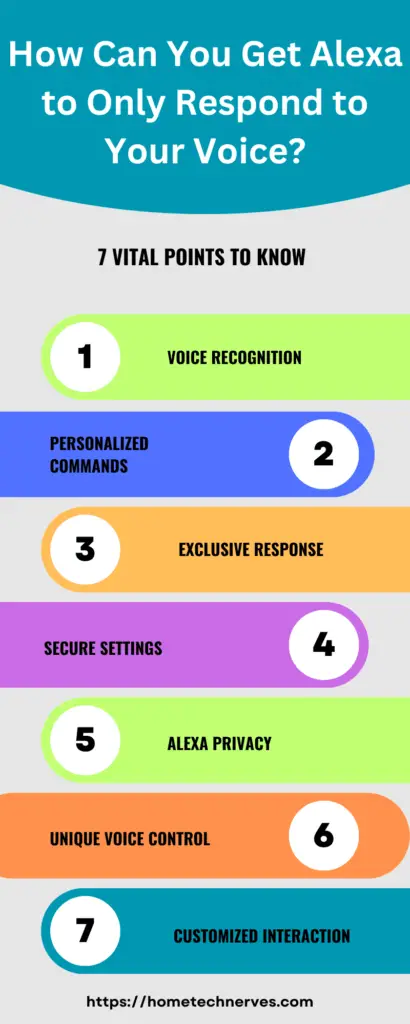Securing exclusive access to Alexa has been a game-changer in simplifying my daily routines. Mastering the art of making Alexa respond only to my voice has enhanced the privacy and personalization of my smart home experience.
In this guide, I’ll share my firsthand expertise in customizing Alexa’s settings, ensuring that it becomes a personalized digital assistant attuned solely to my vocal commands.
With a few simple steps, you can effortlessly establish a secure voice profile, granting you exclusive control over your interactions with Alexa.
Let’s delve into the seamless process of tailoring this smart technology to recognize and respond uniquely to your voice.
Table of Contents
How Can You Get Alexa to Only Respond to Your Voice?
Unlock the full potential of your Alexa device by personalizing it to respond exclusively to your voice commands. In this guide, I’ll walk you through the straightforward process of setting up a unique voice profile, ensuring a secure and tailored smart home experience.
1. Navigate to Voice Recognition Settings:
Accessing Alexa’s voice recognition settings is the initial step. Learn how to locate and enter the settings menu on your Alexa app or device, providing the foundation for creating a personalized voice profile.
2. Enroll in Voice Training:
Discover the significance of enrolling in voice training sessions. Explore the interactive process of teaching Alexa to recognize and distinguish your voice from others, enhancing the accuracy and precision of its responses.
3. Adjust Sensitivity Levels:
Fine-tune your Alexa’s responsiveness by adjusting sensitivity levels. Understand how to strike the right balance, ensuring that your device remains attuned to your voice while minimizing the chances of unintentional activations.
4. Utilize Multi-Factor Authentication:
Enhance security by incorporating multi-factor authentication. Delve into the added layer of protection offered by voice-controlled passcodes, fortifying your Alexa device against unauthorized access.
5. Manage Voice Profiles Effectively:
Learn the art of managing multiple voice profiles efficiently. Whether it’s family members or trusted friends, explore how to seamlessly integrate and organize distinct voice profiles within your Alexa ecosystem, fostering a customized experience for everyone.

How to Make Alexa Only Respond to Your Voice?
Personalize your Alexa experience by ensuring it responds exclusively to your voice. Follow these straightforward steps to establish a secure and tailored smart home interaction.
- Access Voice Recognition Settings: Navigate to your Alexa app or device settings to initiate the process.
- Enroll in Voice Training Sessions: Enhance accuracy by actively participating in voice training exercises with Alexa.
- Fine-Tune Sensitivity Levels: Adjust sensitivity settings to strike the right balance for optimal responsiveness.
- Implement Multi-Factor Authentication: Strengthen security by incorporating voice-controlled passcodes for added protection.
- Efficiently Manage Voice Profiles: Organize and integrate multiple voice profiles seamlessly for a personalized experience.
How to Make Alexa Ignore Other Voices?
Customize your Alexa experience by making it disregard other voices and respond solely to yours. Follow these simple steps to create a more personalized and private interaction with your smart home assistant.
- Access Voice Recognition Settings: Open your Alexa app or device settings to begin the customization process.
- Participate in Voice Training Sessions: Enhance Alexa’s ability to recognize your voice by actively engaging in voice training exercises.
- Adjust Sensitivity Levels: Fine-tune sensitivity settings to ensure Alexa responds accurately only to your vocal commands.
- Enable Multi-Factor Authentication: Bolster security by implementing voice-controlled passcodes, preventing unauthorized access.
- Streamline Voice Profile Management: Effectively manage and organize voice profiles, optimizing Alexa for a personalized and exclusive user experience.
Can you Make Alexa Ignore the Child’s Voice?
Alexa does not have a specific feature to ignore or filter out child voices. However, Amazon regularly updates its Alexa features and capabilities, so it’s advisable to check the latest settings and options in the Alexa app or on the Alexa website for any changes or additions to voice recognition features.
As an alternative, you can adjust the sensitivity settings to minimize unintentional activations. Additionally, consider providing voice training using an adult’s voice to improve Alexa’s responsiveness.
Always refer to the most recent Alexa documentation or contact Amazon support for the latest information on customizing voice recognition settings.
How to Prevent Others From Using Alexa?
Secure your Alexa device from unauthorized access by implementing a few simple steps to prevent others from using it. Follow these measures to safeguard your privacy and maintain control over your smart home assistant.
- Set Up Voice Recognition: Enable voice recognition in Alexa settings to ensure it responds only to your designated voice.
- Activate Multi-Factor Authentication: Enhance security by requiring additional verification, such as a passcode, before granting access to Alexa.
- Manage Device Permissions: Review and restrict device permissions in the Alexa app to control who can interact with your smart devices.
- Enable Purchase PIN: Set up a Purchase PIN to prevent unauthorized transactions or voice commands for shopping.
- Regularly Check Device History: Monitor the Alexa app’s device history to review recent interactions and identify any unauthorized use promptly.
How to Get Alexa to Recognize Another Voice?
Expand the versatility of your Alexa device by training it to recognize additional voices. Follow these straightforward steps to seamlessly introduce new users and enhance the inclusivity of your smart home experience.
- Access Voice Recognition Settings: Navigate to the Alexa app or device settings to locate the voice recognition features.
- Initiate Voice Training Sessions: Enroll additional users by guiding them through voice training exercises to familiarize Alexa with their unique vocal patterns.
- Adjust Sensitivity Levels: Fine-tune sensitivity settings to ensure accurate recognition without compromising security.
- Verify Multi-Factor Authentication: Confirm that multi-factor authentication is configured to accommodate and enhance the security of new voice profiles.
- Organize Multiple Voice Profiles: Effectively manage and categorize distinct voice profiles within the Alexa ecosystem for a seamless and personalized experience for each user.
How to Fix Alexa Not Responding to Voice?
Encountering an issue where Alexa isn’t responding to your voice can be frustrating, but resolving it is simpler than you might think. Follow these quick steps to troubleshoot and get your Alexa back on track for seamless interactions.
- Check Internet Connection: Ensure your device is connected to a stable internet connection as Alexa relies on it for voice recognition and responses.
- Verify Microphone Accessibility: Confirm that your device’s microphone is not obstructed, and permissions are granted for Alexa to access it.
- Reboot Your Alexa Device: Perform a quick restart of your Alexa-enabled device to resolve potential temporary glitches affecting voice recognition.
- Update Alexa App: Ensure that your Alexa app is up to date, as outdated software can lead to functionality issues, including voice response.
- Re-train Alexa with Your Voice: Initiate voice training sessions in the Alexa app to re-familiarize your device with your voice and improve recognition accuracy.
How to Stop Alexa From Responding?
Sometimes, you may want a break from Alexa’s responsiveness. Here’s a guide on temporarily stopping Alexa from responding, allowing you to enjoy moments of silence or privacy without interruptions.
- Activate Do Not Disturb Mode: Utilize the “Do Not Disturb” feature in your Alexa settings to temporarily silence responses during specific times.
- Mute the Microphone: Physically mute your Alexa device by pressing the microphone button, ensuring it won’t respond to voice commands.
- Adjust Volume to Minimum: Lower the volume to the minimum level, effectively muting Alexa while keeping the device operational for other functions.
- Pause Voice Responses: Say “Alexa, stop” after requesting to pause voice responses temporarily without disabling the device.
- Explore Privacy Settings: Delve into privacy settings on the Alexa app to customize response settings and limit Alexa’s interactivity according to your preferences.
Wrap Up
Tailoring Alexa to exclusively respond to my voice has transformed my smart home experience. The process, though simple, empowers me with a heightened sense of privacy and personalized control.
Navigating through voice recognition settings, enrolling in training sessions, and adjusting sensitivity levels showcased Alexa’s adaptability.
The added layers of security, like multi-factor authentication, bolstered my confidence in a seamless and exclusive interaction. Efficiently managing voice profiles ensures a tailored experience for everyone.
In this realm of customization, Alexa becomes not just a digital assistant but a personalized companion, enhancing the simplicity and efficiency of daily tasks with the assurance that it truly recognizes and responds to me alone.
Frequently Asked Questions
Can you get Alexa to only respond to your voice?
Yes, with Alexa’s Voice Recognition feature. By setting up voice profiles in the Alexa app, Alexa can recognize individual voices and respond only to authorized users, enhancing privacy and personalization.
How do I set up voice recognition on Alexa?
In the Alexa app, navigate to “Settings,” select “Your Profile,” and then “Voice.” Follow the prompts to create a voice profile by reading aloud a series of phrases. This trains Alexa to recognize your voice and respond only to your commands.
Can Alexa distinguish between different users’ voices?
Yes, Alexa’s Voice Recognition can distinguish between different voices linked to specific profiles. Each user can create a voice profile, allowing Alexa to identify and respond to individual users, providing a personalized experience within a shared environment.
Can I turn off voice recognition on Alexa?
Yes, if you want to disable Voice Recognition, go to the Alexa app, select “Settings,” then “Your Profile,” and choose “Voice.” From there, you can turn off the feature. Disabling voice recognition means Alexa won’t respond exclusively to recognized voices.


